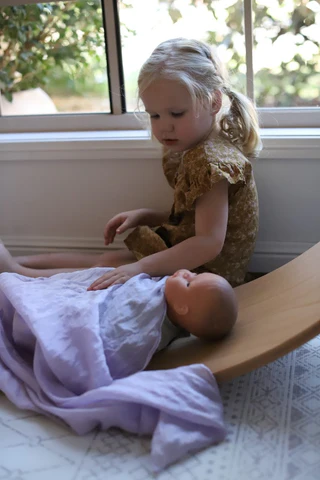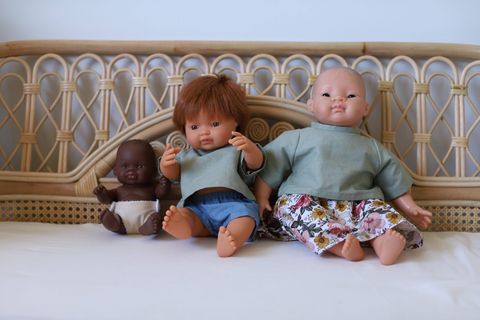
Did you have a favourite doll that you carried everywhere? That never missed an adventure? That over time became dirtier, more loved and your best friend?
This love affair between a child and doll is quintessentially part of childhood and a cornerstone to pretend play. But why is this so important to development and how do we introduce our child to their first doll?
What is Doll Play?
Doll play is an aspect of pretend play that develops in children between 11 and 18 months. It is where children pretend ‘as if’ the doll is real and re-enact scenes and scenarios that they have observed. For example, they might pretend to feed the doll by placing a spoon to the dolls mouth, or wrap it up in their favourite blanket and put it to bed.
You might notice yourself in your child’s play. Some days I can hear my voice being re-enacted in play or see our routine being practiced repeatedly.
This is because this form of play allows them to gain a greater understanding of themselves, their family and the world around them.
Benefits
Science time! In a recent study by Cardiff University, it has been proven that solo doll play lights up the parts of the brain that allow children to develop social-emotional skills including, empathy.
These are the same skills that children develop when children play with others and there is no difference between both boys and girls in these findings. This is exciting as it shows how independent doll play is filled with cognitive and social development benefits for all children.

Cognitive Development
As children must maintain the imaginary parts of their play for extended time, pretend play improves children’s working memory, flexible thinking and self-control. The list of benefits is never ending as children, extend and explore doll play.
Depending on how your child plays they could also be learning to transfer knowledge from one situation to another, develop plans and act on them and problem solve.
Social Emotional Development
Play is a social exploration of the world and dolls are the perfect portal for this exploration. In doll play, children re-enact interactions with others to gain a deeper understanding of the ‘why’ behind things occur (cognitive reframing).
It allows for children to process a range of social situations and develop their ability to view situations from a range of perspectives.
Children enjoy this role as it gives them control over situations that they may not normally have control over. Consider how children re-enact going to the doctors with their dolls, fixing their doll’s owie, bandaging their leg and providing comfort. Re-enacting this scene that might be quite daunting and scary removes the fear and puts your child in control.
Further, doll play allows them to practice their nurturing and caring skills for themselves and others, in a safe environment without the threat of exclusion or rejection. Their doll provides a safe space where they are always accepted for exactly who they are and where they get to set the boundaries and rules of the relationship.
Playing with dolls is also a great way to prepare for or when adjusting to a new sibling joining the family. Through dolls, children can explore the abstract concept of a newborn prior to birth and after birth to feel included in the new dynamic. It is perfect way for children to feel included with the littlest addition to the family as they can act out all of the caring routines for a newborn one their own.

Activities for Doll Play
Fine Motor
Removing and putting on clothes allows children to practice and develop their fine motor skills. You may notice that your child starts with always removing clothes as this is easier to master before they are confident with putting them on.
In introducing clothes start with items that are easier to remove like the Dolly and Zahli floral skirt and sage top as the elastic waist and skirt is easier for little fingers to manipulate. Then build up to pants, buttons and zips.

Self-Help Skills
Dolls are perfect for practicing and discussing self-help skills. Miniland 21cm hard bodied dolls are perfect for giving a bath. While your child does this, discuss different body parts, how to clean and take care of your body (make sure, that you dry the doll and let them fully dry out after their bath).
Extend this with the larger 38cm Miniland dolls with hair care; this is great if your toddler doesn’t like having their own hair brushed. By setting up an invitation to play where they can practice brushing first with their doll and then ask if they would like to try and do their own hair or if you could do their hair … be prepared to have your hair done too!
Speech-Language Skills
Dolls are perfect for discussing and labelling emotions and feelings in a non-threatening manner. It gives an opportunity to discuss how we can identify emotions, navigate big emotions and support each other.
If your child makes a statement along the lines of, “Dolly sad”, it is an open door to starting this discussion. Consider questions like:
- How do you know Dolly is sad? What made you think they are sad?
- What other words could we use instead of sad?
- What can Dolly do to feel better? What would Dolly like us to do to help?
- How can we help Dolly while they are sad?
Other language opportunities with doll play can include sharing and turn taking. Again, if your child wants to give the doll a turn, that is the open door to introducing the language of sharing. Consider asking questions like:
- Whose turn is after Dolly?
- How will we know that Dolly is finished?
- When will it be Dolly’s turn again?

When to Introduce
According to research at around 2 years old children will begin to use objects abstractly, however, pretend play can begin to emerge from as young as 11 months so you don’t need to wait that long to introduce a doll to your child.
How to Choose
The key part is picking the right doll for your child. If you want a doll they will attach to and find easy to use, if possible include your child in picking out the doll either by showing them pictures online or in person!
When picking your doll, consider the size of your doll and your child’s size. Using anatomically correct also allows for open discussions regarding all body parts and for children to explore both sexes and allows for discussions around privacy, consent and difference that is critical for all children.
Finally, consider the diversity seen through your doll collection, as play is the child’s way of understanding their world and our world is diverse, so should be the toys we provide. So, consider dolls of a variety of physical characteristics so children can explore diversity, difference and acceptance of themselves and others.

12 Months Old
Around 12 months look for smaller dolls, like the Miniland 21cm that is easier for little hands to manage and carry. Or the larger soft body doll that is easier to dress and undress and just as easy to carry for little arms.
It is believed that children benefit from dolls that look like them, so for their first doll you may choose a doll that your child can see themselves in.
Your child may not need a lot of accessories for this age and a simple ‘blanket’ can lead to a range of play situations. Sarah’s silks are perfect for this as they are open ended and can be a blanket, bed, dress or swaddle.
If you have a new sibling on the way, consider adding a cot, made for the 21cm Miniland dolls, to their play for them to re-enact the routines with their new sibling.
18 months
Around 18 months to 2 years, you might find your child is more drawn to the larger dolls and these are perfect for growing with your child. It is at this age that introducing a range of diverse dolls would be perfect as they are developing the language to discuss the differences and similarities.
This is also a perfect time to introduce more doll accessories for your child such as a bottle or spoon and bowl. They may also enjoy a pram, as they are building their confidence with walking.
Or consider the bed, as they transition into their own ‘big’ bed, allowing your child to explore and practice the concept first with their doll and them themselves.
This is a guest blog written by Tiffany from @inspire.learn.teach.
